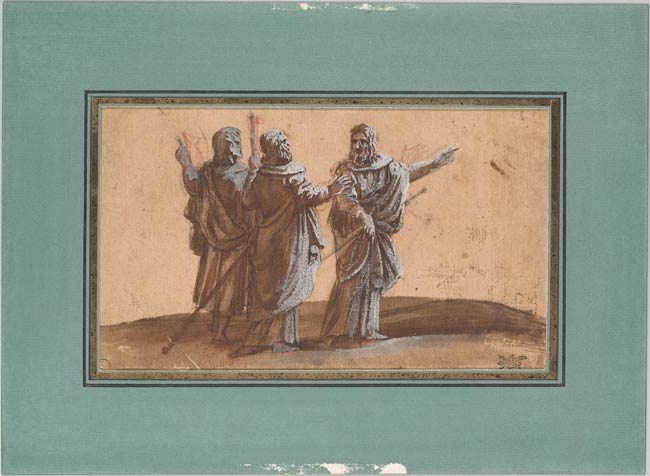
Claude painted two versions of Christ on the Road to Emmaus, one now in the Hermitage, St. Petersburg, and the other a lost painting commissioned in 1652, probably by Jean Delaborne. Our study relates to the lost canvas, which is recorded in a drawing in Claude's Liber Veritatis (British Museum, London). The LV drawing indicates that the figures were placed in the foreground of an expansive Italianate landscape, with a river and fortified hill town in the middle distance. Another study of the figure group and a compositional study in the British Museum reveal Claude's focus on resolving the disposition of Christ and the two pilgrims to successfully convey the narrative.
Claude traced the figures from the recto on the verso of the sheet, making only a small change in switching Christ's staff from his left hand to his right. A sheet from the Wildenstein album also focuses on the same figures, but with an added landscape (Roethlisberger 711). Together, as Roethlisberger argues, these two sheets were used to prepare the figures when the landscape was already on the canvas.
Richardson, Jonathan, 1665-1745, former owner.
Wellesley, Henry, 1791-1866, former owner.
Dubaut, Pierre, former owner.
Goetz, Walter, 1867-1958, former owner.
Thaw, Eugene Victor, former owner.
Thaw, Clare, former owner.
Thaw Catalogue Raisonné, 2017, no. 242, repr.
Stampfle, Felice, and Cara D. Denison. Drawings from the Collection of Mr. and Mrs. Eugene V. Thaw. New York : Pierpont Morgan Library, 1975, no. 20, repr.
Roethlisberger, Marcel. Claude Lorrain. The Drawings, 1968, no. 710.
